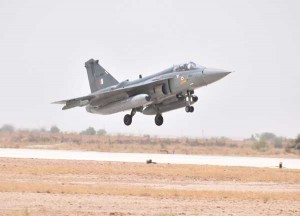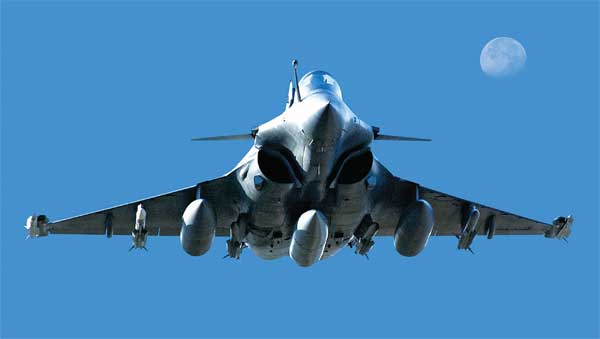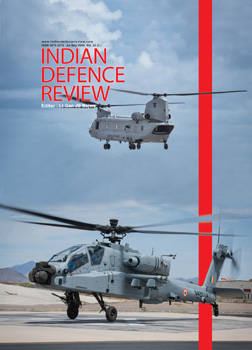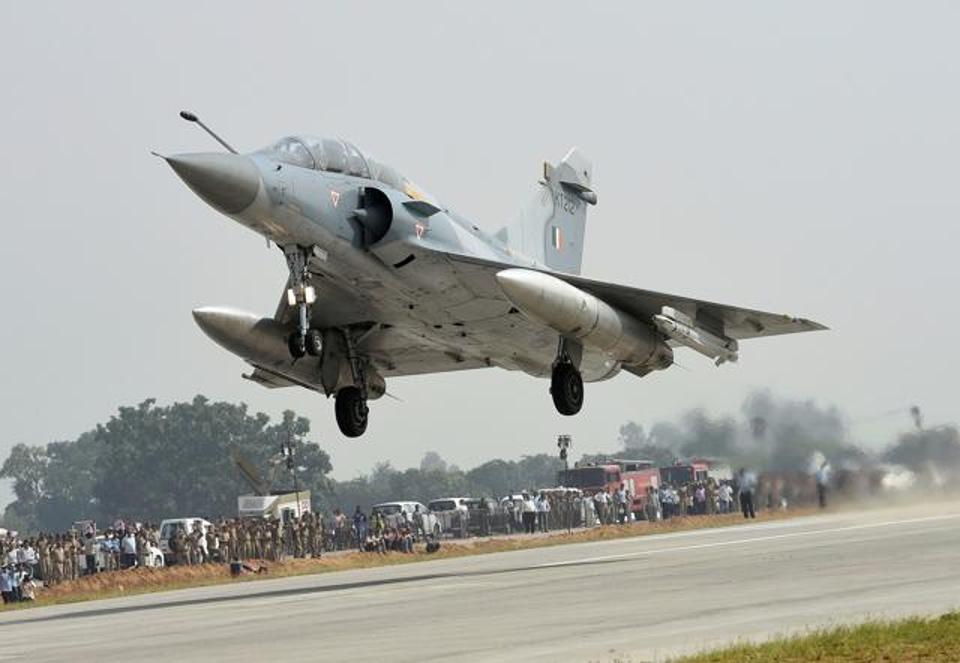The White Paper on China’s Military Strategy 2015 states, “In line with the strategic requirement of building air-space capabilities and conducting offensive and defensive operations, the PLAAF will endeavour to shift its focus from territorial air defence to both defence and offence.” When seen with the military reforms that reorganised the erstwhile Military Regions into five “theatre commands’ exercising joint control over all military forces including the comparatively new Peoples’ Liberation Army Strategic Support Force. Another concern is the raising of Tibet Military Command’s to a status higher than the other provincial commands, an indication of Chinese move to provide it with more resources for its self evident mission against India.
In the event of hostile action initiated by China on any of the disputed territories bordering India, Pakistan would open a second front in unholy haste…
In recent months, the term ‘two-front war’ has acquired prominence in any military-strategic narrative involving India and its two inimical neighbours – China and Pakistan. Allied debates speculate on the possibility of a two-front war, the probable scenarios it could throw up and the varying fortunes the three participants could hope to secure in the war. Given half an opportunity by way of hostile action initiated by China on any of the disputed territories bordering India, Pakistan would open a second front in unholy haste. The possibility of China doing likewise in case of an Indo-Pakistan military engagement exists but the likelihood of that happening is low. However, India needs to be or at least strive to be prepared for a two-front war.
The Indian Air Force (IAF) is currently listed as the fourth largest globally. However, the vast terrain it needs to defend against aerial attack and the enormous stretch of possible battle space in which to support surface forces, are daunting challenges even for its size. Moreover, the vast territories of China and Pakistan combined demand huge offensive capability for counter air operations. Notwithstanding the fourth largest pedestal it occupies, in absolute terms, currently, it is far short of what has been sanctioned in the hazy past as a desirable squadron strength of 42 combat squadrons; the current strength is around 32.
Chinese Threat Confronting The IAF
While India claimed diplomatic triumph over the 73-day confrontation at Doklam, Chinese troops continue to be present in the India-Bhutan-China tri-junction area and the Chinese establishment continues to reiterate that Doklam has always been under its jurisdiction. Both opposing militaries remain at a high state of build up despite an illusory diffusion of tension that had reached breaking point. Indeed, Doklam is a ticking time bomb that could detonate with a suddenness reminiscent of 1962, the year Chinese jolted India out of its somnolescence.
The last White Paper on China’s Military Strategy 2015 states, “In line with the strategic requirement of building air-space capabilities and conducting offensive and defensive operations, the People’s Liberation Army Air Force (PLAAF) will endeavour to shift its focus from territorial air defence to both defence and offence…”. When seen with the military reforms that reorganised the erstwhile Military Regions (MRs) into five ‘theatre commands’ exercising joint control over all military forces including the comparatively new Peoples’ Liberation Army Strategic Support Force. Another concern is the raising of Tibet Military Command’s status to one rank higher than the other provincial commands, an indication of Chinese move to provide it with more resources for its self-evident mission against India. The Chinese front by itself could be worrisome for India.
The Pakistan Air Force (PAF) is a highly skilled and well trained force with pride in its professional capabilities and a good exposure to modern aircraft and tactics through its relations with the West, especially the United States (US)…
As far as air power is concerned, China has been focusing on dual use airports in Tibet from which offensive and defensive missions could be launched. During the last two decades or so, the PLAAF has been modernised through indigenous aerospace industry support and licensed-production of Russian aircraft. A PLAAF Air Division holds around 72 aircraft. After reorganization, the Lanzhou and Chengdu MRs field air assets deployable against India. Chengdu MR had two fighter divisions (with J-7H, J-7II, J-10A, Su-27SK and J-11 fighters) and a transport division, whereas Lanzhou MR had two fighter divisions (J-7H, J-7II, J-8F, J-8H, JH-7A, J-11 and J-11B) and a bomber division (H-6). The prefix ‘J’ denotes a fighter and ‘H’ denotes a bomber. Thus there could be around 300 fighters and 72 bombers that could be tasked against India. The fighters with better performance (Su-27, J-10 and J-11/ J-11B) can be expected to be somewhat effective from the high elevation airports in Tibet while the others may be severely constrained operationally. In the future, J-20 and FC-31 fifth generation, multi-role, stealth aircraft could be expected to join the fray in Tibet; the former earliest in 2020 and the latter much after that. A new long range bomber (H-20) with nuclear capability, is under development but is not expected to complement China’s nuclear triad before 2025. This is a pithy summation of the PLAAF threat that the IAF would face in a war scenario.
Threat From Pakistan
The Pakistan Air Force (PAF) is a highly skilled and well trained force with pride in its professional capabilities and a good exposure to modern aircraft and tactics through its relations with the West, especially the United States (US). After the Pressler Amendment in 1985, the US imposed sanctions and an arms embargo on Pakistan, forcing it to explore other options. China stepped in willingly and supplied aircraft and equipment to the PAF which currently has 22 combat squadrons comprising about 465 combat aircraft (around 50 JF-17s with possibly another 100 on order, 75 F-16s, 75 Mirage IIIs, 80 Mirage Vs and 185 F-7s). The JF-17 Thunder is a Chinese design co-produced in Pakistan Aeronautical Complex, Kamra, Pakistan and Chengdu Aircraft Industry Group, China and is claimed to be a fourth generation, multi-role aircraft. The PAF plans to acquire a total of 250 JF-17 Thunder to replace its fleet of Mirage III and F-7. Some of the JF-17 would be Block 2 aircraft with 4.5 generation features while some more would be Block 3 which are expected to have fifth generation characteristics. The PAF is also said to have placed an order for 36 Chinese J-10 (4.5 generation) aircraft. The J-10 is expected to be inducted as the FC 20, an advanced PAF-specific variant. PAF is consistently and constantly endeavouring to remain close to the leading edge of combat aircraft technology.
Combined Effect
The PLAAF and the PAF have been conducting joint exercises since 2011 under a series named ‘Shaheen’. The sixth edition Shaheen VI was held in China’s Xinjiang province during September this year. At the end of this edition of the exercise, Chinese Defence Ministry spokesperson Colonel Wu Qian stated at a media briefing, “Speaking of Pakistan, the first word that comes to my mind is ‘Iron Pak’…If we characterise Pakistan-China military-to-military relations, the three key terms are ‘all-weather brotherhood, high-level mutual assistance and support and deep-rooted strategic mutual trust.” To the average Indian, such statements hold forth a foreboding portent of a two-front war.
As brought out earlier, the PLAAF and the PAF each singly pose a challenge to the IAF in the event of war with China or Pakistan. The IAF would certainly have operational plans in place for redeployment of its resources should any one of them have to be militarily confronted. Needless to say, a major re-orientation towards one possible adversary would be at the cost of leaving the frontiers with the other comparatively undefended. Standard risk assessment matrices play off probabilities of occurrence against severity of consequences. India needs to heed the fact that while the probability of a two-front war is low, the severity of its consequences on India would be disastrous. The IAF thus needs to be prepared for a two-front war.
 State Of Preparedness Of The IAF
State Of Preparedness Of The IAF
The Indian armed forces have always believed that the probability of a two-front war is high. However, public debate on the issue of two-front war was probably kick-started with the IAF telling the Parliamentary Standing Committee on Defence in February 2014, that it would be somewhat difficult to manage a two-front war with the strength of the combat fleet at 34 squadrons. The IAF, however, had plans to cope to the best of its ability if such a situation did arise. The media lapped up this news and the issue has remained in public domain since then.
“We need 42 squadrons for full spectrum of operations. But it does not mean that we cannot fight a two-front war with the existing strength. We have a Plan B for reduced strength, there are ways in which we can carry out the task,” said the CAS.
The issue came into focus once again when it was highlighted by Air Marshal BS Dhanoa, the then Vice Chief of the Air Staff (VCAS) who told media in March 2016, “Our numbers are not adequate to fully execute an air campaign in a two-front scenario.” A year and a half later, on Air Force Day this year, as the Chief of the Air Staff (CAS) Air Chief Marshal BS Dhanoa declared that the IAF was ready for a two-front war, adding that the probability of such a war was low. Some reports ludicrously claimed that the change in the perception of the IAF had been brought about by the BJP government. However, analysts have remained unimpressed by the Chief’s iteration as no momentous change has taken place in the IAF squadron strength since March 2016. There has also not been any significant reduction in the strength of the PLAAF or the PAF. According to the CAS, the IAF is likely to achieve a 42-squadron strength by 2032. Two years ago, the projection was 2022, possibly based on the proposed induction of 126 Rafale jets from Dassault Aviation of France. He reportedly said that, “We need 42 squadrons for full spectrum of operations. But it does not mean that we cannot fight a two-front war with the existing strength. We have a Plan B for reduced strength; there are ways in which we can carry out the task.”
It is not the intent of this section to detail all roles and tasks the IAF would perform in a two-front war as the scenarios that could be thrown up would be premised on too many variables. A rough comparison shows that the combat strength of the IAF is around one and half times that of the PAF. However, PAF aircraft match up in performance and its pilots are well paid, competent, highly motivated and enjoy first grade status.
IAF pilots are more proficient in advanced air combat tactics especially while operating in a Beyond Visual Range (BVR) environment. The IAF also enjoys significant equipment advantages over the PAF as it has larger numbers of high performance aircraft, operates more BVR-capable platforms, and deploys better on-board sensors and electronic warfare systems. The IAF possesses superior combat support aircraft, better infrastructure and a continually improving integrated air defence network. However, the steadily falling numbers of combat aircraft in the IAF could prove to be critical in the event of a large-scale or protracted war even with only Pakistan as the antagonist especially as the territorial expanse which is to be defended and supported by the PAF, would be much smaller than India’s. This factor could be seen as a disadvantage for the IAF as it would have to spread its resources thinly as compared to the PAF.
As for the PLAAF, it has a substantial superiority in combat aircraft holdings especially so in terms of the numbers it can field in Tibet. China has been indulging in irritating pinpricks across the border and has been making use of its military on the ground on ‘disputed territories’ to remind India of its larger territorial designs. The gradual militarisation of Tibet and the building of infrastructure there is another area of concern for India. A scenario wherein manned and unmanned flights over Indian territory start supplementing the transgressions on the ground, would test India’s strategic fibre and new rules of engagement would have to be prescribed, just as in the case there are transgressions on the ground.
IAF pilots are more proficient in advanced air combat tactics especially while operating in a Beyond Visual Range (BVR) environment…
Inarguably, the current darling of the IAF is the Su-30 MKI, a true air dominance fighter permitting multiple offensive missions due to its speed, firepower, manoeuverability and extended range. With 12 hard points for armament, the Su-30 MKI can also carry the air-launched BrahMos cruise missile which may be expected to be used against strategic targets such as dams, power stations and industrial clusters. Indian Strategic Forces Command (SFC) has also asked for 40 nuclear-capable strike aircraft for the IAF. This, in all probability, will be the Su-30 MKI. Clearly, these roles of the Su-30 MKI render it a crucial player of a two-front war. During exercises designed to rehearse the IAF’s capability for a two-front war, the Su-30 MKIs have been flown across the country over missions 1,800 km; take-offs from airfields in Assam in the East and flights to the Western front with air-to-air refuelling en route, have validated the concept of flexibility of air power and the ability to switch theatres when necessary. With such extended ranges possible, the IAF has the choice to build or develop air bases all around the country as opposed to the earlier ones close to the border with Pakistan.
There is the issue of numbers though. The planned strength of 272, when achieved in 2020, will still be far short of the number of aircraft with similar capabilities that China can deploy. The poor serviceability of the Su-30 MKI fleet in recent months has been a cause for concern. Hopefully, this problem will be alleviated by the planned upgrade of the Su-30MKI to Super Sukhoi, which will have the AL-41F turbofan engine currently powering the Su-35. India has reportedly deployed Su-30 MKI fighters in Chabua and Tezpur obviously with China in mind. In addition, India is speeding up the upgradation and renovation of Advanced Landing Grounds (ALGs) especially in Arunachal Pradesh where the Chinese threat is most likely to come. Five ALGs (Mechuka, Ziro, Along, Walongand Pasighat) are operational and another two (Tuting and Tawang) are likely to be operational soon. Another ALG is proposed to be reconstructed at Vijaynagar but some delay is expected as the roads serving that area are inadequate to support the task. Last year, a Su-30 MKI landed at Agartala, a civil airport. Thanjavur and Pune are other peacetime locations from where Su-30 MKIs would be moved when required to undertake missions directed at Pakistan. However, by itself, the Su-30 MKI/Super Sukhois may not be an adequate deterrent or winner in a two-front scenario.
The planned strength of 272, when achieved in 2020, will still be far short of the number of aircraft with similar capabilities that China can deploy…
In pursuit of air defence of the nation, India is trying to get the Russian S-400 Triumf Surface to Air Missile (SAM) system. The IAF is already using three Israeli Phalcon AWACS on the Russian IL-76 heavy-lift aircraft to detect aerial threats from jets or missiles even from a distance of 400km away. Fifteen more are planned to be added to IAF’s inventory in the coming years but consummation of this plan is in jeopardy as the price of the IL-76 has been hiked so much that even the deal for the next two AWACS aircraft is on hold. An indigenous Airborne Early Warning and Control System (AEW&C) christened ‘Netra’ was handed over to the IAF during the Aero India 2017 in February this year, making India only the fourth country after US, Russia and Israel to have developed the technology on its own.
The MiG-29s, Mirage 2000s and the upgraded Sepecat Jaguars would continue to be available to the IAF for at least a decade to come while the MiG-21s and MiG-27s would all have been retired from service by 2024. The 36 jets that are to be inducted will form two squadrons one of which will be located at Hashimara in the East facing China and the other at Ambala in the West facing Pakistan. The deal for 36 Rafale jets is a small consolation and in any case, commencement of delivery is still a couple of years away with the last of the 36 aircraft expected only by 2024. The Rafale is nuclear-capable and can reach substantial parts of Tibet and most parts of Pakistan. The IAF needs to get a much larger number of Rafale jets to justify the investment in infrastructure as also the high cost of training pilots. The probability of that happening appears low as the current buzzword is the new single-engine fighter and the associated hype about Make In India!
The process of selecting a single-engine fighter is moving at a characteristically indolent pace and at the time of writing, the Request For Information (RFI) is expected to be issued in October this year for 114 aircraft. The Lockheed Martin F-16 and Saab Gripen are the hot contenders and both have been lobbying strongly while entering into Joint Ventures with Indian entities (Tata Advanced Systems Ltd. and Adani Group respectively) in the hope of landing the contract. However, the selected aircraft will take a long time to become effective at the front line as only 16 aircraft are likely to be flown off the OEM’s assembly line with the rest being manufactured in India.
The IAF needs to get a much larger number of Rafale jets to justify the investment in infrastructure as also the high cost of training pilots…
The widening gap in squadron strength is not likely to be filled by the indigenous Light Combat Aircraft Tejas which is yet to be operationalised. The availability of an operational Tejas Mk1A variant is not expected before 2022, while the Tejas Mk1 already delivered and being produced, is not an operational aircraft. In any case, Hindustan Aeronautics Limited (HAL) is presently capable of producing only eight aircraft per year and that rate of production is slower than the expected attrition of the older aircraft. HAL has plans to double the rate of production, though the timeframe for this achievement is not defined. Even when operational versions of the Tejas become available, their capability will be no match for the single-engine aircraft selected, be it F-16 or Gripen. However, in terms of numbers, the Tejas can be spread to cover larger expanses of the two-front war scenario the IAF could face.
The collaborative Fifth Generation Fighter Aircraft (FGFA), planned to be developed jointly by India and Russia, is an unknown that may enter the two-front war calculus in the distant future. Right now, there are too many uncertainties about its future and there have already been several mis-starts.
Conclusion
Addressing the gathering at the Air Force Day parade on the occasion of the 85th anniversary of the IAF, the CAS said, “The nature of conflict in the present geo-political environment may require us to fight a short and swift war for which we need to be alert and prepared to fight on a short notice.” Ideally, the IAF should have had the staying power of fighting a two-front war for 30 days. As of now, that is a distant dream. So is the dream of achieving a 42-squadron strength. The uncertainties of the FGFA’s future, the final capability of the Tejas, the choice of a single-engine fighter and the time it would take for it to enter service, when weighed against the certainty of a dwindling MiG fleet, paint a grim picture at the moment. Whenever the IAF does reach a strength of 42 squadrons, it would be time to reassess the sanctioned strength in the context of the prevailing geopolitical realities. In all probability, a review by the IAF will find the figure of 42 inadequate to the task of fighting a two-front war.
In the context of a two-front war, according to Brigadier Gurmeet Kanwal (Retd), “India cannot hope to terminate the conflict on India’s terms and impose the nation’s will upon the adversaries.” However, as the IAF grapples with the possibility of a two-front war, it is determined to give a good account of itself if hostilities become unavoidable. This is evident from the Chief’s iterations in the recent past and in consonance with historical evidence of IAF’s culture of proud professionalism. It is for the government to find the means and the inclination to meet IAF’s critical aircraft and equipment needs. It would also be advisable for the government to re-examine the establishment’s acts of commission and omission over the last three years or so which are tending to erode the morale of the defence services.







